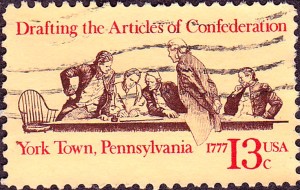Difference between Articles of Confederation vs Constitution
Two of the most prominent documents to manifest during the American Revolution were the Articles of Confederation and the Constitution.
The Articles of Confederation was the first successful effort of organizing and mobilizing the original thirteen colonies of the United States. Prior to its inception, all American activities deemed subversive to the Crown of England were viewed in the same way that terrorism is deemed today. These rebel activities acted independently of a sovereign authority. As a result, the revolutionary forces in the United States couldn’t leverage or seek the assistance of other foreign governments., leaving them tactically and diplomatically weak against its British foe.
The Continental Congress, in need of domestic unity and foreign assistance, pushed for the ratification of these documents in 1776. It wasn’t until 1781 that the group was able to finalize the document, which acted as one-third of the United States’ founding documents (also including the Declaration of Independence and the Model Treaty). The Articles of Confederation gave the original colonial powers some added leverage in handling diplomatic affairs, including negotiating land deals with foreign governments.
Following the American Revolution, the Articles of Confederation reemerged as a topic of intense conversation. American nationalists, recently emboldened by their victory over the English crown, claimed that the Articles of Confederation did not provide an adequate central authority for purposes of governance. There was no established executive power. There was no judicial branch, so disputes couldn’t be adequately arbitrated. International treaties were adopted with the Articles of Confederation, but individual states were able to violate these treaties at will, putting the United States in a bad place diplomatically in the late 18th century. Most importantly, there was no taxing authority, so money couldn’t be collected to pay off the American war expenses and debt. The Continental Congress was able to print money, but the money was rendered worthless. The term “not worth a Continental” became widespread during this era.
There were key differences between the two documents in the how they both codified the law. The Articles of Confederation established a unicameral legislature, as opposed to the eventual bicameral system created by the Constitution. Voting power was delegated to states based on committees (consisting of anywhere from two to seven people) and each state had one vote in the Articles of Confederation; the Constitution allowed for a single vote for each legislative representative (for each state, two Senators and a number of House representatives based on census population). Furthermore, the Constitution created the Executive Branch of government, establishing a figurehead department of the government that was still held accountable to public scrutiny. In the grand scheme of things, the Constitution did more to centralize authority in a single political entity, rather than rely on the more lax union created by the Articles of Confederation.
The American Constitution was adopted in 1789, replacing the Articles of Confederation permanently. This document laid out a much more expansive system of governance, creating the checks and balances between the three branches of government. It also enumerated the relationship of the Federal Government and the states. Most importantly, it established the Bill of Rights, the first ten amendments of the Constitution which laid out the foundation for the civil liberties we enjoy as American citizens. The Constitution was a unique document for its time. It inspired many other countries to follow in a similar fashion for the development of their own democratically based reformations.
However, despite its originality, the Constitution was not perfect. Intentionally vague from its inception, the Constitution did not address several prominent issues, such as the institution of slavery. Since its inception, the Constitution has been amended several times. Even then, new additions to the Constitution – such as the 18th Amendment which outlawed the sale of alcohol and started the Prohibition – were subject to repeal. Now, the document possesses 27 amendments and 7 articles. Despite this seemingly large document, the U.S. Constitution is one of the shortest constitutions in existence to date.
- Difference Between Vascular Cambium and Cork Cambium - November 1, 2023
- Difference Between DevOps and Developer - September 10, 2023
- Difference Between Acute Gastritis and Chronic Gastritis - April 3, 2023
Read More ESL Articles
Search DifferenceBetween.net :
19 Comments
Leave a Response
References :
[0]http://commons.wikimedia.org/wiki/File%3AArticles_of_Confederation_1977_Issue-13c.jpg


This is very good info
This is very good info 🙂 :^] :]
This really helped me in school
this is good
nice name faggot
what
This is blaspamy!
blasphemy*
This is Sparta!
Very cool kanye
This will be really helpful for me with my schoolwork for jonors history thank you so much.
This is really good. It helped me with school and I am going to look into more of this.
AIDS
Presidential AIDS
very good :)) rlly helpful to sishter study
cringe
I’m not a bot this is good and very helpful
Add me on snapchat @slurpdurp6969
what do you post